Beef and Carrot Plov with Chickpeas
Plus: The Four Questions Interview with Lisa Gross of The League of Kitchens
The Jewish Table is a reader-supported publication. If you are able, please consider becoming a paid subscriber (or gifting a subscription to a friend) so I can continue the research, writing, and recipe development it takes to bring you stories and recipes from around the Jewish globe. Thank you so much!
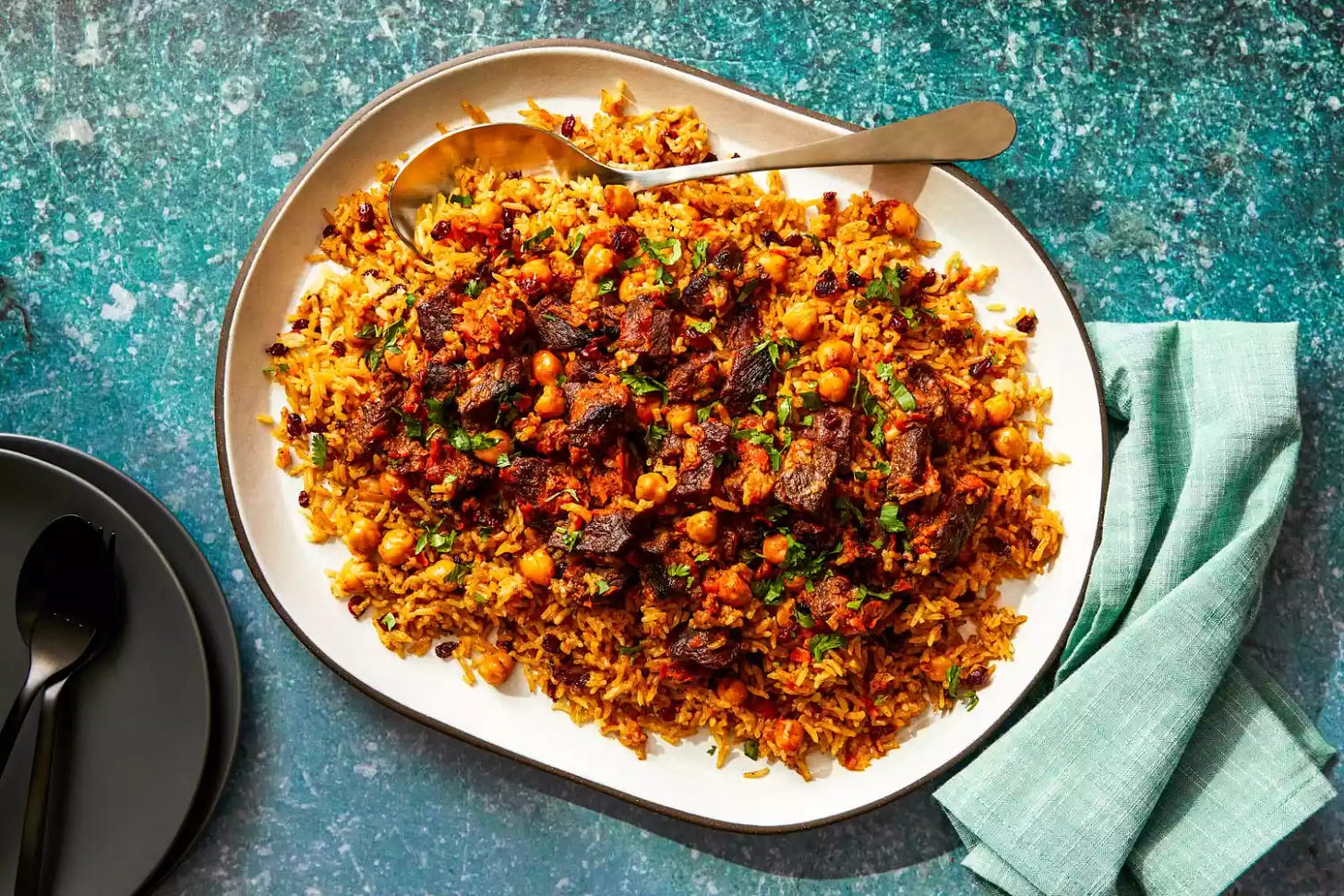
My understanding of Jewish cuisine has been exploded (in a good way!) many times over my career. The example I talk about most, of course, is Rome - where the Jewish community is so ancient, it predates both Ashkenazi and Sephardi culture. Eating fried artichokes and pine nut and raisin-studded bar cookies in Rome’s historic Jewish ghetto impacted me so profoundly, I’m writing my next cookbook about it!
Another standout moment happened sometime in 2009 or 2010, when some friends asked if I’d like to go eat Bukharian food in Queens. I immediately said “Yes!” Then I asked, “What’s Bukharian food?” Was I ever in for a delightful surprise.
For folks not familiar (like I wasn’t), Bukharian Jews are a Jewish community hailing from Central Asia - primarily from present-day Uzbekistan, Tajikistan, and Turkmenistan. The community, which traces its roots back to ancient Persia, lived in relative isolation from the rest of the Jewish world for thousands of years. So their rituals, traditional clothing, culture, and cuisine are completely unique - a mashup of Iranian roots, Soviet influence, and the myriad cultures they encountered and interacted with while living along the heart of the Silk Road.
Fewer than 1,000 Jews call Central Asia home today. The majority of the community fled crumbling Soviet rule in the mid-to-late 20th century, and today, there are approximately 120,000 Bukharian Jews living in Israel and more than 40,000 (!!) in New York City. Of that population, 80% of the city’s Bukharian Jews are congregated in Queens’ Rego Park neighborhood.
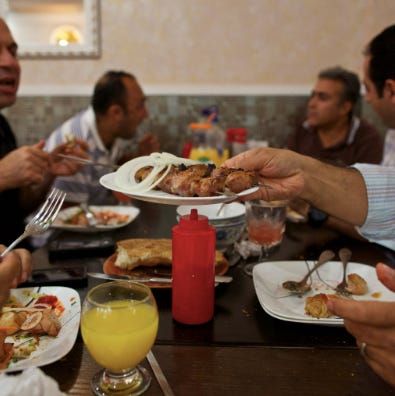
It was in Rego Park, at one of the many kosher restaurants, bakeries, butcher shops, and grocery stores lining 108th Street (which is often referred to as Bukharian Broadway), that I fell in love with this singular cuisine. The shatteringly crisp samsi filled with pumpkin or cumin-spiced lamb! The charred kebabs strung on flat metal skewers and piled with thinly sliced onion! The chewy rounds of bread baked in clay tandyr ovens! The intricately spiced beef and vegetable stew (called lagman), which comes brimming with hand-pulled noodles! The refreshing glasses of kompot (homemade fruit punch)!
I loved it all. I loved it so much I wrote about it. And then I wrote about it again and again. And I go back to Queens whenever I can, feeling so grateful to live in a city where Jewish food means babka and pastrami, but also so much more.
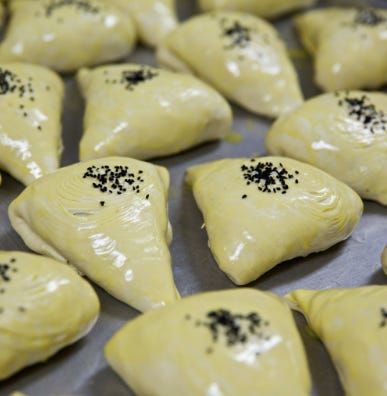
Plov: AKA Bukharian Rice Pilaf
Of all of the Bukharian dishes I have tasted over the years, nothing compares to plov - a glistening melange of rice and meat that belongs in the larger rice pilaf family. As I wrote in Food & Wine:
Uzbekis regard plov as their national dish…It is a beguiling and sensuous dish, traditionally eaten with one's hands from a shared central vessel. The most ubiquitous versions are made with beef, lamb, or mutton. Softened onions and matchsticks of yellow carrots are standard additions, as are chickpeas, entire heads of garlic, and dried fruit including sultanas or barberries.
Plov is essentially a pilaf, but there is nothing “side dish” about it. Whenever plov is on the table, it is the main event. Its ingredients are relatively humble - rice, stew meat, carrots, chickpeas, and onions, plus spices and some dried fruit - but the result is nothing less than a feast. Like their Central Asian neighbors, Bukharian Jews traditionally serve plov on holidays, and at weddings and other special occasions. And when Jews from Uzbekistan and the surrounding region immigrated to Queens, they naturally brought plov with them.
Today, I’m sharing the plov recipe from my cookbook The Jewish Cookbook because it is delicious, cozy, and perfect for a chilly autumn evening. But the recipe also relates directly to today’s “The Four Questions” interview with Lisa Gross from The League of Kitchens. (Read on to see why.)
I have loved all of the conversations I’ve had through The Four Questions interview series. But this interview with Lisa felt particularly special. (You’ll see what I mean when you read it!) Please make sure you scroll down past the recipe and give it a few minutes of undivided attention. And don’t miss the very special offer from The League of Kitchens below.
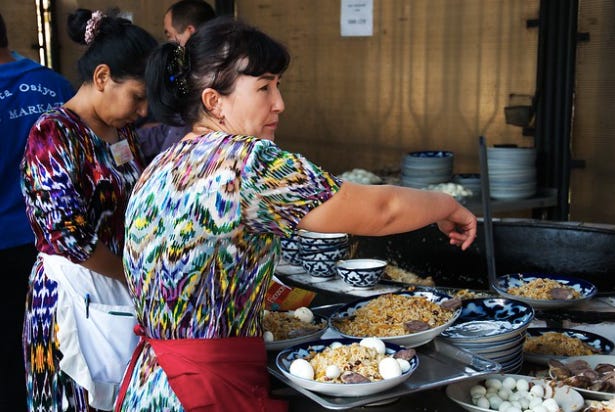
Beef and Carrot Plov with Chickpeas
Plov isn’t difficult to make, but it takes a bit of time prepare. Plan to make it on a lazy (or at least relatively lazy!) Sunday to enjoy for a cozy supper - and then as supremely delicious leftovers well into the week.
This recipe is reprinted with permission from The Jewish Cookbook (Phaidon, 2019), by Leah Koenig
Serves 8
1/3 cup (75 ml) vegetable oil
2 medium yellow onions, finely chopped
6 medium garlic cloves, finely chopped
2 ½ pounds (1 kg) beef chuck, trimmed of excess fat and cut into 3/4-inch pieces
1 pound (455 g) carrots, grated on the large holes of a box grater
2 ½ teaspoons kosher salt, plus more as needed
¼ teaspoon freshly ground black pepper
2 teaspoons ground cumin
1 teaspoon ground coriander
1 teaspoon sweet paprika
2 bay leaves
1 can (15 ounces/425 g) chickpeas, rinsed and drained
2 ½ cups (500 g) medium or long-grain white rice, soaked in water for 30 minutes and drained*
⅓ cup (45 g) dried currants or barberries
Roughly chopped cilantro leaves, for serving, optional
In a large Dutch oven or other heavy-bottomed pot, heat the oil over medium-high heat. Add the onions and garlic and cook, stirring occasionally, until softened and lightly browned around the edges, 6 to 8 minutes. Add the beef and cook, stirring occasionally, until browned in spots, 7 to 10 minutes.
Add the carrots and cook, stirring occasionally, until just softened, 3 to 5 minutes. Add 1 1/2 teaspoons salt, the black pepper, cumin, coriander, paprika, and bay leaves and cook, stirring constantly, until fragrant, about 1 minute.
Stir in 2 cups water, bring to a simmer over medium-high, then reduce the heat to low, cover, and cook until the meat is tender, 45 to 60 minutes. Uncover and stir in the chickpeas.
Sprinkle the rice and the remaining 1 teaspoon salt evenly over the beef mixture (do not stir). Pour 3 cups water on top and bring to a boil over high heat without stirring. Reduce the heat to medium and cook, uncovered, until the rice begins to swell and most of the water is absorbed (the surface should appear dry), 10 to 12 minutes.
Poke several deep holes in the rice mixture to the bottom of Dutch oven with the back of a wooden spoon to facilitate evaporation. Sprinkle the currants on top, reduce the heat to low, and cook, covered, until the rice is tender and water is fully absorbed, 15 to 20 minutes. Remove from the heat and let stand, covered, for 15 minutes, then gently stir to combine. Taste and add more salt, if desired. Serve hot or warm, topped with cilantro, if desired.
*Calrose rice from Trader Joe’s works especially well in plov, so keep an eye out for it if you have a TJ’s near you.
The Four Questions: with Lisa Gross of The League of Kitchens
Welcome to the latest installment of The Four Questions, The Jewish Table’s semi-regular interview segment featuring Jewish food luminaries. This week I’m delighted to be joined by Lisa Gross, the founder and CEO of The League of Kitchens (LoK).
The League of Kitchens offers cooking classes with “a culinary dream-team of women from around the world,” who welcome guests into their homes (in person and virtually!) to teach their family’s recipes and share their personal stories. LoK’s instructors hail from Afghanistan, Argentina, Greece, Japan, Nepal, India, and several other countries.
I’ve taken two classes with The League of Kitchens. The first was an in-person experience led by Damira - a wonderful woman from Uzbekistan who moved to Brooklyn’s Borough Park neighborhood with her husband in 2013. Damira is not Jewish herself, but many of the foods she taught in her class overlapped with the Bukharian dishes I enjoy at restaurants in Queens. Cooking in her kitchen with the other students was such an inviting and intimate experience. It felt like I was walking into my own grandmother’s kitchen.
The second class I took was a virtual workshop with Larisa, a Russian-Jewish instructor who lives in Jackson Heights, Queens. I invited a bunch of friends from around the country to join me in celebrating my pandemic birthday, and it was such a treat. Cooking together over a computer screen felt different, of course. But Larisa was so warm and knowledgable - and the borscht and pampushki (garlicky rolls) we made were so delicious - it hardly mattered.
As Gross’ bio states, “As the daughter of a Korean immigrant and a Jewish New Yorker, Lisa was raised on one grandmother's denjang-guk and the other's matzoh ball soup. The League of Kitchens was born out of her love of cooking, her connection to the immigrant experience, and her desire to connect people across difference.” Now that is a mission I can get behind!
In a lucky coincidence, Lisa and her family live just a few blocks from me in Brooklyn, and I often run into her and her two kiddos en route to/from bringing Max to the school bus. :) Our proximity also means that she and I occasionally get together for coffee in the neighborhood, which is always a delight.
In celebration of this particular conversation, Lisa extended a very generous offer to readers of The Jewish Table. If you register for any League of Kitchens class or workshop (virtual or in-person) before November 9, 2022, you can use the code JT20 for $20 off the registration fee!
How would you describe your relationship to Jewish food and how has it changed over the years?
When I think of my relationship to Jewish food, I think of my Jewish grandmother Gloria (my other grandmother, my halmoni, was from Korea). Gloria was a smart, sophisticated, stylish New Yorker who was extremely competent and loved beautiful things. She also liked being in charge and hated waiting. She and my grandfather moved to Great Neck shortly after my father was born and stayed in the same house until they died, about 50 years later.
We always went to my grandparents’ house for Thanksgiving and Passover, and those Passover foods–brisket, chopped liver, chicken soup with matzo balls, gefilte fish with prepared horseradish–form my core emotional connection to Jewish food. (I even love the gefilte fish gel!) Gloria’s parents had immigrated from Hungary in the 1910s, before she was born, and overall she was not interested in “her roots” or being a traditional Jewish grandmother. But she did love being a gracious and elegant hostess, so she pulled out all the stops at Passover. That festive scene–the white table cloth, the wedding plates and sterling silver, drinks and appetizers served in the “den”, lots of grown-up chatter (I was usually the only child), is what I think of when I think of Jewish food.
But beyond Passover, and eating bagels and smoked salmon on the weekends for breakfast, I didn’t feel very connected to Jewish food growing up. Because my Korean grandmother lived with my family and cooked dinner almost every night, Korean food was much more present in my life. (Though, I went to a Jewish day school from the ages of 3-13, so Jewish culture was very dominant, just not Jewish food.)
A few years ago I did a course on Jewish Ancestral Healing with Taya Mâ Shere, and this work brought me back to Jewish food in a new way–as a way to connect more deeply with my Jewish ancestors. Going through a folder of Gloria’s recipes that my aunt put together after Gloria died (most were 1950s gems featuring canned mushroom soup and Lipton’s onion soup mix), I found my great grandmother’s recipe for palacsinta (crepes that taste kind of like blintz wrappers, that are usually filled with apricot jelly or farmers’ cheese). It felt very meaningful to make that recipe, our one true family recipe, and to make something specifically Hungarian Jewish, rather than a pan-Ashkenazi classic that I was familiar with.
In what way did your Jewish food heritage influence or inspire your work with the League of Kitchens (LoK)?
I’m not sure that my Jewish food heritage specifically inspired my work with the LoK, but I do think that the LoK stems very much from my experience living within and between two very different cultures and food cultures (though they are united by a love of pickles!). I was always both an insider and an outsider, and though this could be painful at times, it also gave me the ability to move easily between cultures and to understand them from both within and without.
This experience is central to my role as the CEO and founder of the LoK. It gave me the ability to connect deeply with our instructors, who are from all over the world, to understand the perspectives of our students, who are mostly American, and to create an experience that bridges the two.
Can you share something that inspired or surprised you that you learned from one of the LoK teachers?
I’ve learned so many things from all of our instructors over the last 10 years, both small practical things and larger philosophical things, that it’s very hard to choose what to share!
I’ve learned a lot about heat and controlling heat with intention. From our South Asian instructors, Yamini, Rachana, and Afsari, I’ve learned that when you’re blooming spices in oil or ghee, it needs to be really hot so that your spices pop and sizzle. (I always used to underheat the fat, so they never really toasted and released their full flavor.) But you do have to watch them closely or they’ll burn! From our Iranian instructor Mab, I learned the opposite lesson–the art of cooking “low and slow” over a barely visible flame, and trusting that it’s actually doing something and that your patience will be rewarded.
From Nawida, our Afghan instructor, and Jeanette, our Lebanese instructor, I’ve learned that the way you cut up your vegetables really matters and changes a dish. Some dishes need large pieces of vegetables (much larger than I would naturally cut them), and some need really tiny pieces. Sometimes your onions need to be sliced from root to stem, and sometimes they need to be sliced the other way–parallel to the equator. Those kinds of small details are the difference between something tasting good and something tasting exceptional.
But one thing they all say is that the best, most delicious food, is cooked with love–that’s the secret ingredient. In some ways this sounds like a meaningless cliche. But I’ve thought about this a lot, and this is what it means to me: cooking with attention and care because you’re making food for people you love, as an expression of your love. It means cooking with those people and their individual tastes in mind. It means making your food look beautiful–not to impress, but to please and delight. It means not rushing and not checking your phone while cooking (and letting things burn or overcook). This way of cooking is not always possible for all of us at all times (as someone who runs a business and cooks daily for a family that includes a 5 year old and a 8 year old, I really get that), but it’s a beautiful north star to follow.
Do you have any family food rituals/traditions that you’ve passed down from when you were growing up, or that you’re creating with your kids?
Besides Passover and Thanksgiving, my family didn’t have many food traditions or rituals, and the food at both holidays was good, but pretty standard. My grandmother was not going to have bad food at an event she hosted, but she was not that interested in cooking. So besides the aforementioned palacsinta recipe, there aren’t any family recipes from my family to pass on. We also didn’t celebrate any Korean holidays. But food was still the main way my family gathered together and celebrated.
One of the results of getting married is learning and experiencing a whole other set of family traditions. My husband Dan’s family is of Ashkenazi Jewish descent (from Lithuania, Poland, Ukraine, Austria, and Germany vs. my Jewish family that is 100% Hungarian), and so I feel like my marriage, and now having kids, has deepened my connection to Ashkenazi Jewish food. Dan’s paternal grandmother Elsa was an excellent cook who left behind a full box of hand-written recipe cards. My mother-in-law Linda, who is also an excellent cook, has carried forward many of Elsa’s most famous recipes: chicken soup where the “soup vegetables” are pushed through a strainer into the broth; cranberry sauce jello mold dotted with Manischewitz-soaked canned cherries; a dairy extravaganza of a noodle kugel that includes butter, whole milk, cottage cheese, sour cream, and cream cheese. I love these recipes, and Dan and I are excited to continue making them and to pass them down to our kids, who already make noodle kugel every year with Dan for Yom Kippur break fast.
In the last couple of years, I’ve also started cooking Korean food for Chuseok, the Korean harvest holiday, and Seollal, the Korean New Year, including putting together a Jesa table–a table of ceremonial food offerings for the ancestors. (You eat the food after ritually offering it to the ancestors and bowing in front of the table). My mother and grandmother never did this, maybe because it didn’t seem to fit into a Jewish family in suburban Maryland, but I’m glad to be doing this with and for my kids.
I also cook food from all over the world. Now that I’m deep into recipe development for the League of Kitchens cookbook (coming out in the fall of 2024!), our table has become particularly diverse. I hope that some of our instructors’ recipes–recipes from our kids’ “aunties”-will also become family food traditions that they continue and pass down.
Experience League of Kitchens’ magic!
Register for any League of Kitchens class or workshop (virtual or in-person) before November 9, 2022, and use the code JT20 for $20 off the registration fee.



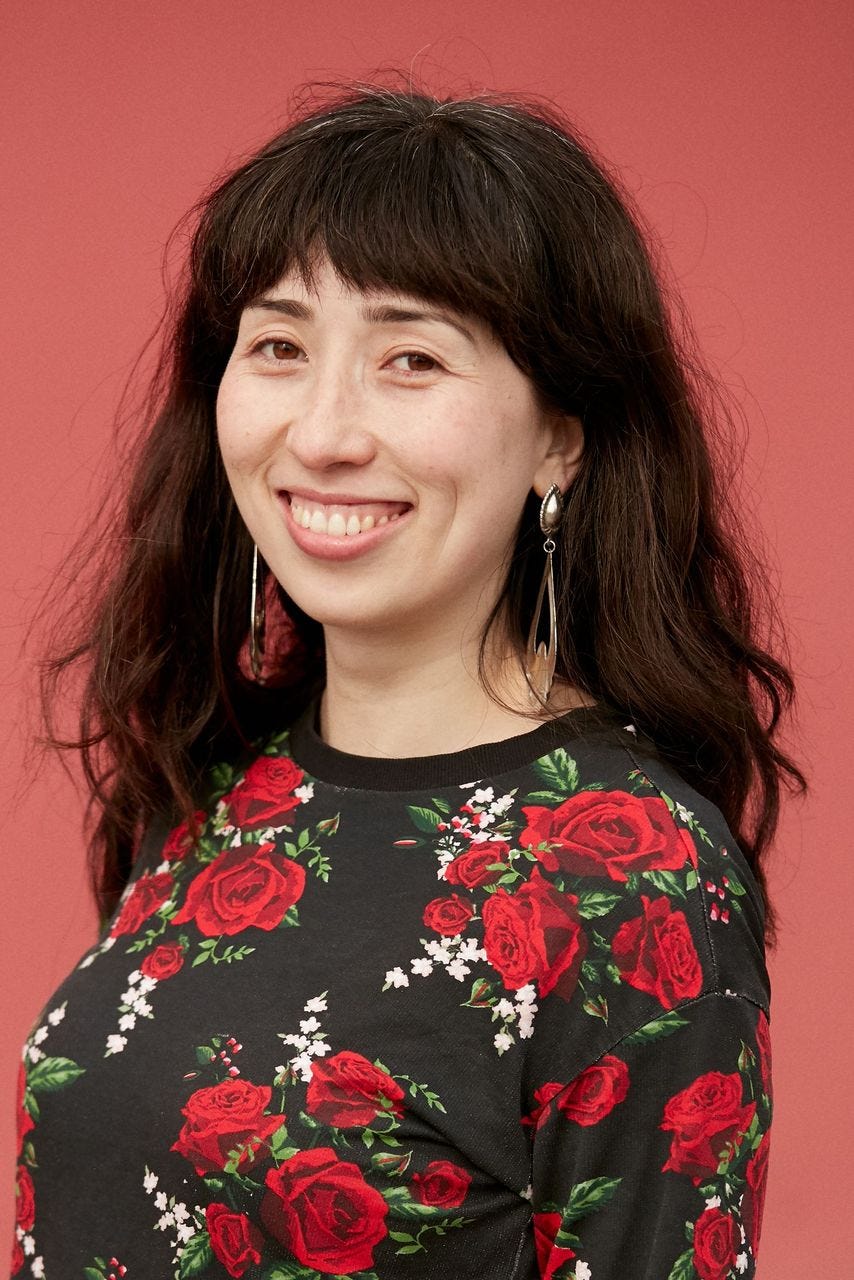
So much good stuff to "digest" in this addition of the Jewish Table. I enjoyed reading it and learning about the League of Kitchens. Definitely will try the recipe too. xoxo
I read this early morning after my gym session and let me tell you that this made me so happy 🙂. I'm too a home cook and love to feed people. The thing that fascinates me is how food travels and connects different cultures and people. That's what I learnt from Plov. Also, through this edition I explored Kitchen of league classes. Such a great thing to provide platform to women home cooks